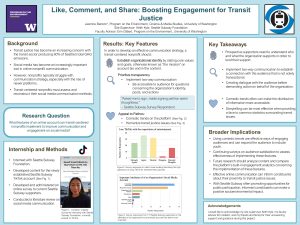Like, Comment, and Share: How Social Media Can Boost Engagement for Transit Justice
Social media is an emerging tool for nonprofit communication, but there is limited research on short- form video content. Moreover, minimal research concerning the online communication of transit justice in the nonprofit sector limits the use of short-form platforms. The aim of this study was to develop strategies for effective transit-centered communication on the platform TikTok. To accomplish this task, I created TikTok posts for the new Seattle Subway Foundation TikTok account. Then, I created and distributed an online survey to current Seattle Subway members asking them to reflect on social media expectations, important attributes of an online account, and assess three of my TikTok posts about public transit expansion. Additionally, I conducted a literature review of nonprofit communication case studies focusing on current online communication strategies such as two-way communication and rhetorical appeals. Findings show three central attributes of organizational social media accounts that have proven to establish audiences and increase engagement: organizational identity, transparency, and persuasive appeal. While 9.6% of respondents prefer storytelling, appealing to pathos, only 7% of respondents cited transparency as an important attribute despite researchers citing its importance in gaining trust and establishing a consistent audience. Transparency can be achieved through clearly stating organizational goals and values and elevated by storytelling appealing to an individual experience. Understanding the current relationship Seattle Subway members have with online communication methods can inform strategies to improve organizational content and engagement. Moreover, proper communication equips with information to participate in opportunities for public comments, and possible votes concerning transit justice.
Social media is an emerging tool for nonprofit communication, but there is limited research on shortform video content. Moreover, minimal research concerning the online communication of transit justice in the nonprofit sector limits the use of short-form platforms. The aim of this study was to develop strategies for effective transit-centered communication on the platform TikTok. To accomplish this task, I created TikTok posts for the new Seattle Subway Foundation TikTok account. Then, I created and distributed an online survey to current Seattle Subway members asking them to reflect on social media expectations, important attributes of an online account, and assess three of
my TikTok posts about public transit expansion. Additionally, I conducted a literature review of nonprofit communication case studies focusing on current online communication strategies such as two-way communication and rhetorical appeals. Findings show three central attributes of organizational social media accounts that have proven to establish audiences and increase engagement: organizational identity, transparency, and persuasive appeal. While 9.6% of respondents prefer storytelling, appealing to pathos, only 7% of respondents cited transparency as an important attribute despite researchers citing its importance in gaining trust and establishing a consistent audience. Transparency can be achieved through clearly stating organizational goals and values and elevated by storytelling appealing to an individual experience. Understanding the current relationship Seattle Subway members have with online communication methods can inform strategies to improve organizational content and engagement. Moreover, proper communication equips constituents with information to participate in opportunities for public comments, and possible votes concerning transit justice
